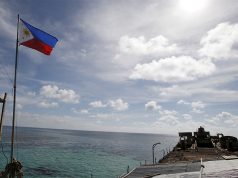MANILA, Philippines – Former national security adviser Roilo Golez is wondering why the Duterte administration is not doing something about China’s “militarization” of Subi or Zamora Reef, which he said is part of the Philippines based on a law defining the country’s archipelagic baseline.
“Why is the Philippine government not protesting the militarization of Subi Reef? It is only 12 nautical miles from Pagasa, Kalayaan Island Group, which is part of the Philippine territory under RA (Republic Act) 9522,” said Golez, former Parañaque City representative and chair of the House Committee on Defense, in a Facebook post last Saturday, February 17.
He added that like China’s militarization of Mischief Reef and Fiery Cross Reef, what is being done now in Subi Reef “is a threat to Philippine Security.”
Subi or Zamora Reef, which is 230 nautical miles from Palawan, was among the eight maritime features that the Philippine government included in its January 22, 2013 case against China before the Hague-based Permanent Court of Arbitration (PCA).
On July 12, 2016, the PCA ruled in favor of the Philippines, saying China has “no legal basis…to claim historic rights within the sea areas falling within the nine-dash line,” which include Subi.
According to Golez, the Asia Maritime Transparency Initiative had compared their satellite photos with the aerial photos published recently by the Philippines Daily Inquirer and came out with findings “clearly showing the military facilities” in Subi “like the three-kilometer runway, hangars of 24 combat planes and radars.”
“The aerial imagery of Subi Reef is dated October 10, 2017, and includes close looks at facilities on both the northern and southern arms of the base (but not the majority of the airstrip that runs along its western side),” he said.
“Subi has been of particular concern to Manila because of its location just over 12 nautical miles from the main Philippine-occupied feature of Thitu Island,” added Golez
He said facilities apparent in the aerial imagery include:
1. Buried storage facilities, presumed to be for fuel, water, or other base necessities.
2. A sensor/communications facility topped by a radome.
3. Mobile shipping crane used to transfer cargo between ships and dock facility. In the satellite image, it can be seen at the middle of the dock next to several ships, while in the Inquirer photo it is at the eastern end of the dock.
4. One of the four point defense facilities built around the base in 2016.
5. A large lighthouse.
6. The over 3,000-meter airstrip, completed in early 2016.
7. Hangar space for 20 combat aircraft, completed by late 2016. Another four such hangars stand at the northern end of the runway.
8. Four bigger hangars for large aircraft, completed in early 2017.
9. Underground storage tunnels, likely for ammunition and other materiel, built during 2017. Identical buried storage facilities can be found on Fiery Cross and Subi Reefs.
10. A high frequency “elephant cage” radar array, so called because the circular construction of the antennae resembles a tall fence.
11. One of the four point defense facilities built around the base in 2016.
12. Hardened structures with retractable roofs believed to be shelters for mobile missile launchers, completed in 2017. He said that based on the Inquirer photo, “the top of the radome for the nearby tower, which will presumably be used for targeting, can be seen assembled on the ground, waiting for installation.”










